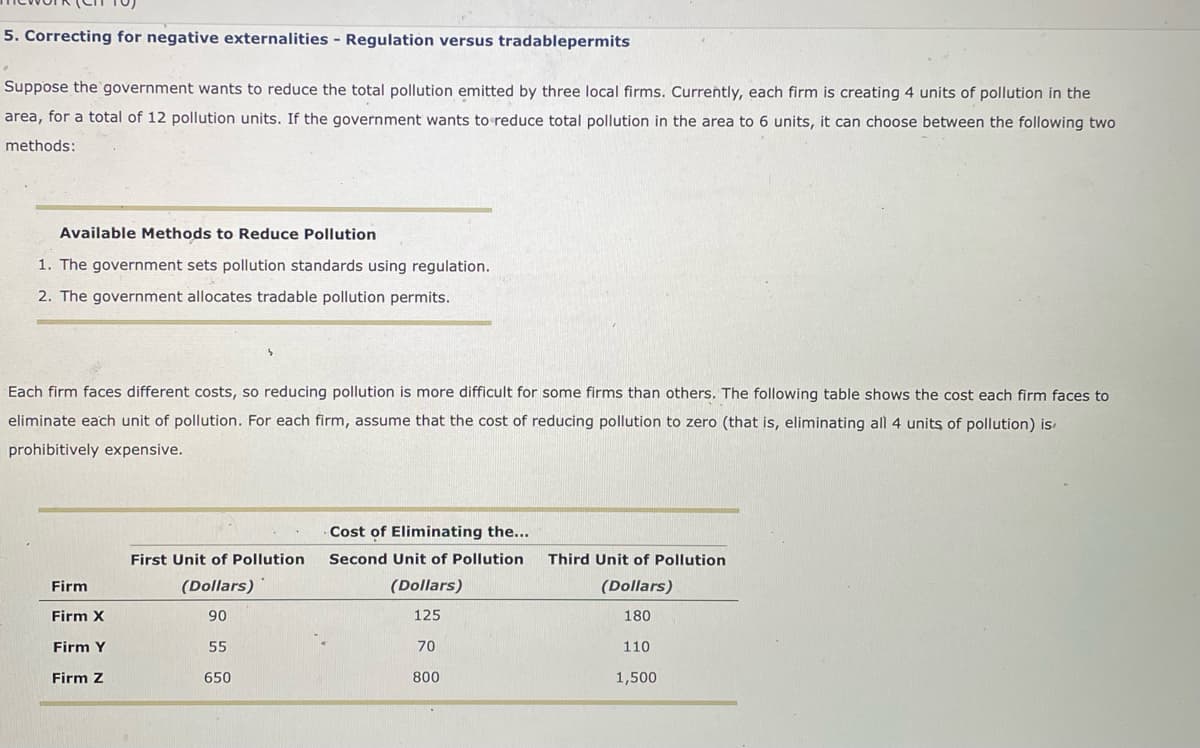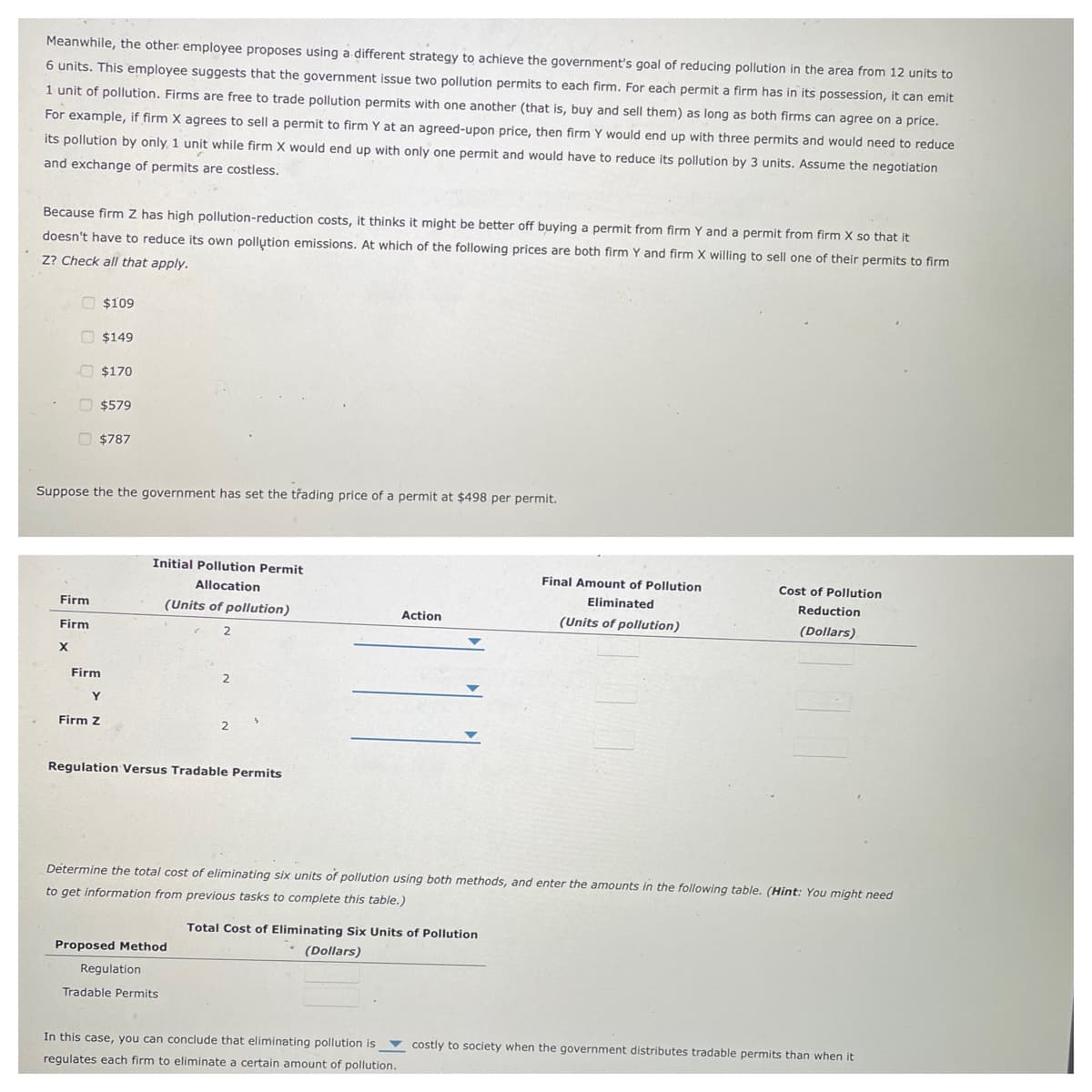Suppose the government wants to reduce the total pollution emitted by three local firms. Currently, each firm is creating 4 units of pollution in the area, for a total of 12 pollution units. If the government wants to reduce total pollution in the area to 6 units, it can choose between the following two methods: Available Methods to Reduce Pollution 1. The government sets pollution standards using regulation. 2. The government allocates tradable pollution permits. Each firm faces different costs, so reducing pollution is more difficult for some firms than others. The following table shows the cost each firm faces to eliminate each unit of pollution. For each firm, assume that the cost of reducing pollution to zero (that is, eliminating all 4 units of pollution) is prohibitively expensive. Cost of Eliminating the... First Unit of Pollution Second Unit of Pollution Third Unit of Pollution Firm (Dollars) (Dollars) (Dollars) Firm X 90 125 180 Firm Y 55 70 110 Firm z 650 800 1,500
Suppose the government wants to reduce the total pollution emitted by three local firms. Currently, each firm is creating 4 units of pollution in the area, for a total of 12 pollution units. If the government wants to reduce total pollution in the area to 6 units, it can choose between the following two methods: Available Methods to Reduce Pollution 1. The government sets pollution standards using regulation. 2. The government allocates tradable pollution permits. Each firm faces different costs, so reducing pollution is more difficult for some firms than others. The following table shows the cost each firm faces to eliminate each unit of pollution. For each firm, assume that the cost of reducing pollution to zero (that is, eliminating all 4 units of pollution) is prohibitively expensive. Cost of Eliminating the... First Unit of Pollution Second Unit of Pollution Third Unit of Pollution Firm (Dollars) (Dollars) (Dollars) Firm X 90 125 180 Firm Y 55 70 110 Firm z 650 800 1,500
Principles of Microeconomics
7th Edition
ISBN:9781305156050
Author:N. Gregory Mankiw
Publisher:N. Gregory Mankiw
Chapter10: Externalities
Section: Chapter Questions
Problem 5PA
Related questions
Question

Transcribed Image Text:5. Correcting for negative externalities - Regulation versus tradablepermits
Suppose the government wants to reduce the total pollution emitted by three local firms. Currently, each firm is creating 4 units of pollution in the
area, for a total of 12 pollution units. If the government wants to reduce total pollution in the area to 6 units, it can choose between the following two
methods:
Available Methods to Reduce Pollution
1. The government sets pollution standards using regulation.
2. The government allocates tradable pollution permits.
Each firm faces different costs, so reducing pollution is more difficult for some firms than others. The following table shows the cost each firm faces to
eliminate each unit of pollution. For each firm, assume that the cost of reducing pollution to zero (that is, eliminating all 4 units of pollution) is
prohibitively expensive.
Cost of Eliminating the...
First Unit of Pollution
Second Unit of Pollution
Third Unit of Pollution
Firm
(Dollars)
(Dollars)
(Dollars)
Firm X
90
125
180
Firm Y
55
70
110
Firm Z
650
800
1,500

Transcribed Image Text:Meanwhile, the other employee proposes using a different strategy to achieve the government's goal of reducing pollution in the area from 12 units to
6 units. This employee suggests that the government issue two pollution permits to each firm. For each permit a firm has in its possession, it can emit
1 unit of pollution. Firms are free to trade pollution permits with one another (that is, buy and sell them) as long as both firms can agree on a price.
For example, if firm X agrees to sell a permit to firm Y at an agreed-upon price, then firm Y would end up with three permits and would need to reduce
its pollution by only 1 unit while firm X would end up with only one permit and would have to reduce its pollution by 3 units. Assume the negotiation
and exchange of permits are costless.
Because firm Z has high pollution-reduction costs, it thinks it might be better off buying a permit from firm Y and a permit from firm X so that it
doesn't have to reduce its own pollution emissions. At which of the following prices are both firm Y and firm X willing to sell one of their permits to firm
Z? Check all that apply.
O $109
O $149
O $170
O $579
O $787
Suppose the the government has set the trading price of a permit at $498 per permit.
Initial Pollution Permit
Final Amount of Pollution
Cost of Pollution
Allocation
Eliminated
Reduction
Firm
(Units of pollution)
Action
(Units of pollution)
(Dollars)
Firm
Firm
Y
Firm z
Regulation Versus Tradable Permits
Détermine the total cost of eliminating six units of pollution using both methods, and enter the amounts in the following table. (Hint: You might need
to get information from previous tasks to complete this table.)
Total Cost of Eliminating Six Units of Pollution
Proposed Method
(Dollars)
Regulation
Tradable Permits
In this case, you can conclude that eliminating pollution is
costly to society when the government distributes tradable permits than when it
regulates each firm to eliminate a certain amount of pollution.
Expert Solution
This question has been solved!
Explore an expertly crafted, step-by-step solution for a thorough understanding of key concepts.
This is a popular solution!
Trending now
This is a popular solution!
Step by step
Solved in 3 steps

Knowledge Booster
Learn more about
Need a deep-dive on the concept behind this application? Look no further. Learn more about this topic, economics and related others by exploring similar questions and additional content below.Recommended textbooks for you

Principles of Microeconomics
Economics
ISBN:
9781305156050
Author:
N. Gregory Mankiw
Publisher:
Cengage Learning

Principles of Economics, 7th Edition (MindTap Cou…
Economics
ISBN:
9781285165875
Author:
N. Gregory Mankiw
Publisher:
Cengage Learning

Principles of Economics (MindTap Course List)
Economics
ISBN:
9781305585126
Author:
N. Gregory Mankiw
Publisher:
Cengage Learning

Principles of Microeconomics
Economics
ISBN:
9781305156050
Author:
N. Gregory Mankiw
Publisher:
Cengage Learning

Principles of Economics, 7th Edition (MindTap Cou…
Economics
ISBN:
9781285165875
Author:
N. Gregory Mankiw
Publisher:
Cengage Learning

Principles of Economics (MindTap Course List)
Economics
ISBN:
9781305585126
Author:
N. Gregory Mankiw
Publisher:
Cengage Learning

Essentials of Economics (MindTap Course List)
Economics
ISBN:
9781337091992
Author:
N. Gregory Mankiw
Publisher:
Cengage Learning

Principles of Microeconomics (MindTap Course List)
Economics
ISBN:
9781305971493
Author:
N. Gregory Mankiw
Publisher:
Cengage Learning

Principles of Economics 2e
Economics
ISBN:
9781947172364
Author:
Steven A. Greenlaw; David Shapiro
Publisher:
OpenStax